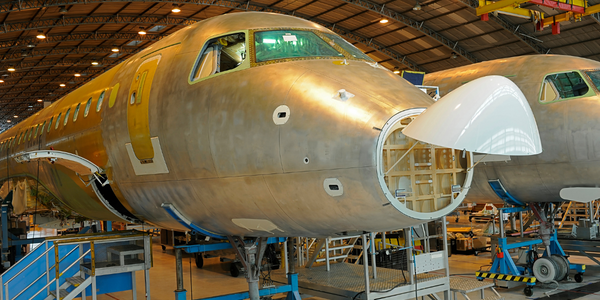下载PDF
Aerospace Manufacturer Enabled by Manufacturing Execution System to Produce Safety Critical Electronics

技术
- 功能应用 - 制造执行系统 (MES)
适用行业
- 航天
适用功能
- 产品研发
用例
- 过程控制与优化
挑战
本文档总结了航空航天零件制造商实施的制造执行系统 (MES) 或制造运营管理 (MOM) 解决方案,以便在其装配过程中引入全面问责制。 MES/MOM 通过提供一个管理装配过程各个方面的控制系统来实现“过程的完整性”;并创建了一个问责制闭环,每次都能交付预期的结果。实现其目标的一个关键方面是管理新的装配线劳动力。对 MES/MOM 系统可靠性的真正考验在于,它使几乎没有经验的操作员能够按照最高质量标准构建复杂的电子元件。还值得注意的是,MES/MOM 能够在不到四 (4) 天的非常短的时间内完成集成和运行。
客户
未公开
关于客户
波音航空航天 OEM 电子供应商
解决方案
鉴于 MES/MOM 软件的交钥匙性质,工厂车间管理系统的快速集成和配置成为可能,该软件可通过任何计算机、平板电脑或智能手机上的任何网络浏览器访问。当客户看到系统在四 (4) 天内安装并运行时,他们感到非常欣慰和印象深刻,也就是说,缺乏经验的劳动力在一周内就可以生产出高质量的“安全关键”零件。解决方案是扩大成熟的 MES/MOM 系统,以确保装配线上的所有流程(无论是通过工具、设备还是人工)在工厂范围内进行防错。制造执行系统通过将“全面问责”文化引入客户的制造运营,促成了整体范式转变。 “……PINpoint 教会了我们流程问责制的真正含义、财务价值以及如何最大化我们已经拥有的装配设备的利益。” ~ 航空航天 OEM 供应商 航空航天制造商能够使用 MES/MOM 以对装配线工人最有意义的方式配置呈现给他们的通信,并提供易于理解的无纸化工作说明,包括展示他们的任务的图片、图形和视频是要执行。生产线工人逐步得到指导,MES/MOM 验证每一步是否符合要求。
运营影响
数量效益
相关案例.

Case Study
Airbus Soars with Wearable Technology
Building an Airbus aircraft involves complex manufacturing processes consisting of thousands of moving parts. Speed and accuracy are critical to business and competitive advantage. Improvements in both would have high impact on Airbus’ bottom line. Airbus wanted to help operators reduce the complexity of assembling cabin seats and decrease the time required to complete this task.

Case Study
Aircraft Predictive Maintenance and Workflow Optimization
First, aircraft manufacturer have trouble monitoring the health of aircraft systems with health prognostics and deliver predictive maintenance insights. Second, aircraft manufacturer wants a solution that can provide an in-context advisory and align job assignments to match technician experience and expertise.

Case Study
Aerospace & Defense Case Study Airbus
For the development of its new wide-body aircraft, Airbus needed to ensure quality and consistency across all internal and external stakeholders. Airbus had many challenges including a very aggressive development schedule and the need to ramp up production quickly to satisfy their delivery commitments. The lack of communication extended design time and introduced errors that drove up costs.

Case Study
Developing Smart Tools for the Airbus Factory
Manufacturing and assembly of aircraft, which involves tens of thousands of steps that must be followed by the operators, and a single mistake in the process could cost hundreds of thousands of dollars to fix, makes the room for error very small.

Case Study
Accelerate Production for Spirit AeroSystems
The manufacture and assembly of massive fuselage assemblies and other large structures generates a river of data. In fact, the bill of materials for a single fuselage alone can be millions of rows of data. In-house production processes and testing, as well as other manufacturers and customers created data flows that overwhelmed previous processes and information systems. Spirit’s customer base had grown substantially since their 2005 divestiture from Boeing, resulting in a $41 billion backlog of orders to fill. To address this backlog, meet increased customer demands and minimize additional capital investment, the company needed a way to improve throughput in the existing operational footprint. Spirit had a requirement from customers to increase fuselage production by 30%. To accomplish this goal, Spirit needed real-time information on its value chain and workflow. However, the two terabytes of data being pulled from their SAP ECC was unmanageable and overloaded their business warehouse. It had become time-consuming and difficult to pull aggregate data, disaggregate it for the needed information and then reassemble to create a report. During the 6-8 hours it took to build a report, another work shift (they run three per day) would have already taken place, thus the report content was out-of-date before it was ever delivered. As a result, supervisors often had to rely on manual efforts to provide charts, reports and analysis.






